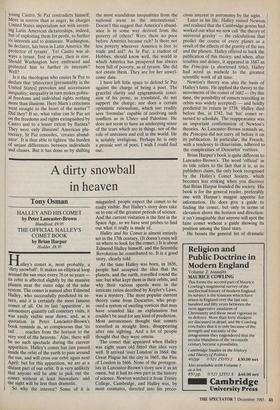A dirty snowball in heaven
Tony Osman
HALLEY AND HIS COMET by Peter Lancaster-Brown
Blandford, f9.95
THE OFFICIAL HALLEY'S COMET BOOK by Brian Harpur
Hodder, f8.95
Halley's comet is, most probably, a `dirty snowball'. It makes an elliptical loop around the sun once every 76 or so years its orbit is affected slightly by the massive planets near the outer edge of the solar system. The comet is named after Edmond Halley, who successfully predicted its re- turn, and it is certainly the most famous comet of all. On its last 'apparition', as astonomers quaintly call cometary visits, it was easily visible near dawn, and, as a quotation in Peter Lancaster-Brown's book reminds us, so conspicuous that 'its tail . . . reaches from the horizon to the very roof of the heavens.' Alas, there will be no such spectacle during the current apparition. Halley's comet has just passed inside the orbit of the earth to pass around the sun, and will cross our orbit again next April: but for this apparition, we are at a distant part of our orbit. It is very unlikely that anyone will be able to pick out the comet without at least binoculars: and the sight will be less than dramatic.
So why the interest? Some of it is misguided: people expect the comet to be easily visible. But Halley's story does take us to one of the greatest periods of science. And the current visitation is the first in the Space Age, so we have sent probes to find out what it really is made of.
Halley and his Comet. is almost entirely set in the 17th century. (It doesn't even tell us where to look for the comet.) It is about Edmond Halley himself, and the Scientific Revolution he contributed to. It is a good story, clearly told.
At the time Halley was born, in 1656, people had accepted the idea that the planets, and the earth, travelled round the sun: but what kept them in their orbits, and why their various speeds were in the intricate ratios decribed by Kepler's Laws, was a mystery. The most popular current theory came from Descartes, who prop- osed a system of swirling vortices that may have sounded like an explanation but couldn't be used for any kind of prediction. Most astronomers thought that comets travelled in straight lines, disappearing after one sighting. And a lot of people thought that they were omens.
The comet that appeared when Halley was eight years old fitted that idea very well. It arrived 'over London' in 1664: the Great Plague hit the city in 1665, the Fire of London in 1666. None of the protagon- ists in Lancaster-Brown's story saw it as an omen, but it had its own part in the history of science. Newton watched it from Trinity College, Cambridge, and Halley was, by most estimates, directed into his preco- cious interest in astronomy by the sight. Later in his life, Halley visited Newton and realised that the Cambridge genius had worked out what we now call 'the theory of universal gravity' — the calculations that predict the course of every planet as a result of the effects of the gravity of the sun and the planets. Halley offered to back the publication of this theory: and when, after troubles and delays, it appeared in 1687 as the Principia (a shortened title), Halley had acted as midwife to the greatest scientific work of all time.
Newton's theory was also the basis of Halley's fame. He applied the theory to the movements of the comet of 1682 — (by this time, the possibility of comets travelling in orbits was widely accepted) — and boldly predicted its return in 1758. Halley died before this, in 1742, but 'his' comet re- turned to schedule. The reappearance was an important confirmation of Newton's theories. As Lancaster-Brown reminds us, the Principia did not carry all before it on its publication. In particular, the French, with a tendency to chauvinism, adhered to the complexities of Descartes' vortices.
Brian Harpur's book is quite different to Lancaster-Brown's. The word 'official' in its title refers to the fact that it is, as its publishers claim, the only book recognised by the Halley's Comet Society, which becomes less striking when you discover that Brian Harpur founded the society. His book is for the general reader, preferably one with Harpur's magpie appetite for information. He does give a guide to finding the comet, but only in terms of elevation above the horizon and direction: it isn't imaginable that anyone will spot the faint comet without a guide showing its position among the fixed stars.
He boosts the general list of dramatic events associated with apparitions — the Battle of Hastings, the French defeat by General Wolfe at Quebec, for example with events, good and bad, that happened in the years before and after apparitions. In 1913 'Stravinsky's Rite of Spring is performed', we are told, and Richard Nixon was born. The information might come in handy for a game of 'Trivial Pursuits' but it certainly isn't rivetting. The book isn't about 17th- and 18th-century astronomy, so that the importance of Halley's work is not made clear, nor is it really about the comet. It is a collection of loosely associated facts and gossip.



































































 Previous page
Previous page